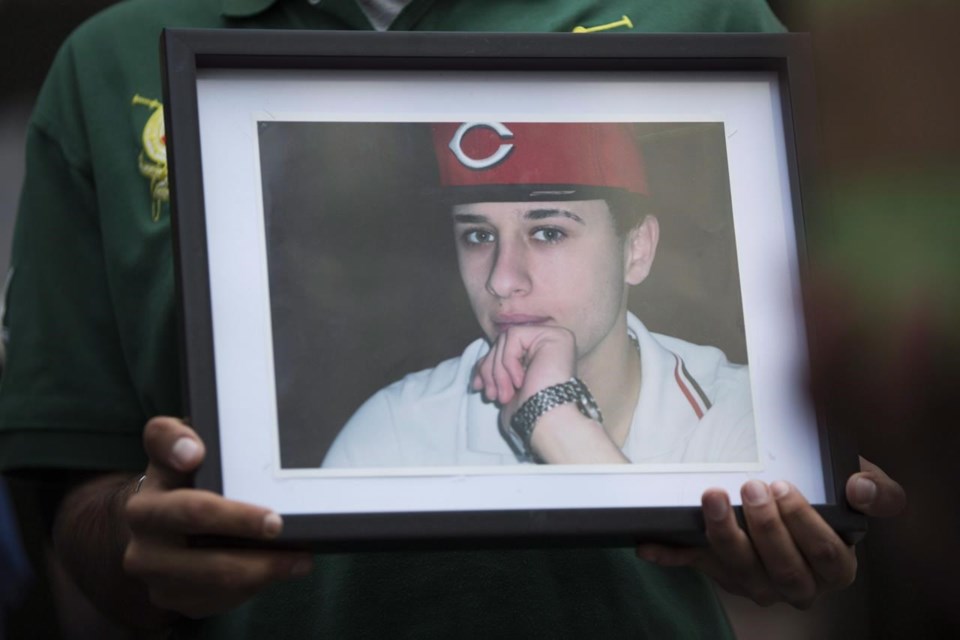TORONTO — Jurors at an inquest into the death of a teen shot by a Toronto police officer more than a decade ago were asked Tuesday to consider dozens of recommendations related to officer training and monitoring, peer intervention and mental health supports in an effort to prevent future deaths.
As closing submissions began in the inquest into the death of Sammy Yatim, coroner's counsel presented a list of more than 50 recommendations jointly proposed by the parties, which include Yatim's family members, the Toronto Police Services Board, and some police officers involved in the incident. Jurors can review the proposal as they deliberate and compile their list of recommendations.
One proposed recommendation calls for making peer intervention training, which already exists within the force, a mandatory component of officers' annual requalification process. The training should emphasize that officers who intervene will not face repercussions and those who don't could be accused of misconduct, it said.
Another seeks a review of the database system used to monitor use-of-force incidents and other occurrences, which is meant to provide alerts after a certain number of incidents to allow early intervention.
"What we have learned throughout this inquest is that at the time of Sammy's death, the systems in place at the Toronto Police Service that were designed to oversee and monitor police officers ... were insufficient in assisting the officers to be able to work through the situation with Sammy and to defuse it without the loss of life," said Asha James, who represents Yatim's mother.
"While the Toronto Police Service and the Toronto Police Services Board have made some advancements in the 10 years since Sammy's death, it is important that these changes are continually reviewed and evaluated to determine what best practices for police should be," she added later in her submissions.
"To save the next Sammy, we must be proactive, not reactive."
Mental health and financial support for families whose loved ones have died in interactions with police, which Yatim's relatives have called for, was also among the recommendations.
Lawyers representing Yatim's father and sister noted the sharp contrast between the support offered to officers after Yatim's death and the absence of such help for the family. Officers should receive support, said Julia Chumak, but Yatim's relatives "were and continue to be left behind."
"No one was there to help them in the middle of the night on July 27, 2013. And there's no one to help them now – no one to call, and no one to help pay for counselling or in-patient mental health support."
Yatim, who was 18 at the time, was alone on a streetcar and holding a small knife when he was hit by two volleys of shots shortly after midnight on July 27, 2013.
The officer who shot him, then-Const. James Forcillo, was found not guilty of second-degree murder in connection with the first volley of bullets, which court heard was fatal, but was convicted of attempted murder for the second volley, fired when Yatim was already on the ground.
Forcillo was sentenced to six and a half years behind bars and was granted full parole in 2020.
Ed Upenieks, one of the lawyers for Yatim's father and sister, stressed the need to strengthen officer monitoring and early intervention.
He pointed out that Forcillo had "a history of complaints" against him for his "brusque" dealings with the public, and had drawn a firearm six times in the 15 months before the confrontation with Yatim.
"I suggest that the red flags were there," he said. "Whatever may have happened ... was too little, too late. In 2012, 2013, there was no intervention, even though the officer had drawn his handgun four times and a shotgun twice."
In his closing submissions, Forcillo's lawyer said three things could have changed the outcome of that night: access to a stun gun, peer intervention training and better de-escalation training.
There has been improvement on all three fronts since Yatim's death, Peter Brauti said, "but that does not mean that there is not more work to do."
Aside from those issues, Brauti also urged jurors to consider recommendations related to better monitoring of use-of-force incidents, and mental health supports for both officers and people affected by police use of force.
Three additional recommendations have been proposed by individual parties and may not be supported by others, jurors heard.
Jurors have been told that the inquest should focus on police decision making and best practices in dealing with people in crisis, and is not meant to re-examine the details of the shooting or Forcillo's actions that night.
This report by The Canadian Press was first published Jan. 30, 2024.
Paola Loriggio, The Canadian Press




